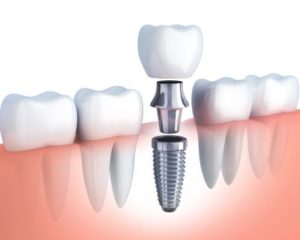Dental Implant Vs Crown: Pros & Cons
Dental crowns or dental implants are two options for teeth restoration. A crown is a covering that goes over an existing tooth and resembles a tooth. It can be applied to patch up a cracked tooth. A dental implant is a surgical replacement for a lost tooth that is covered by a crown to mimic the appearance and function of a natural tooth. Knowing more about the advantages and disadvantages of each choice is necessary in order to choose between the two. Here is a comparison between dental crowns and implants.
What Is a Dental Implant?
A dental implant is effectively a replacement tooth once it is finished, in contrast to a crown, which, when used by itself, is affixed to a partial natural tooth. A metal post known as an implant serves as a tooth’s artificial root. Its size and shape are identical to those of a typical metal screw, and it is similarly inserted into your jawbone. This post is not the replacement tooth on its own. It is the post to which the dental implant is fastened. An abutment is fastened to the top of the implant, and a crown is affixed to it when the gum tissue has healed and the implant has been placed. The visible portion of the prosthetic tooth is its crown.
Dental Implants Pros and Cons
Dental implants and crowns have several advantages, but they are really employed to treat slightly dissimilar problems. Let’s discuss.
Pro: Dental implants can last a lifetime
Dental implants can last a lifetime, as opposed to a dental bridge, which might only last 10 years or so. Overall, an implant creates a strong substitute tooth.
Pro: Dental implants prevent bone loss
Lack of stimulation causes the jaw bone where there is no tooth to degenerate. Without an implant, the bone surrounding the missing tooth loses 25% of its volume in the first year after tooth loss, and the bone loss continues over time.
Dentures frequently become loose and then rub against the bony ridge, eventually eroding it away. This can even hasten bone loss. An implant stimulates natural bone growth because it replaces the tooth’s root as well as the tooth, restoring chewing to normal.
Pro: Dental implants prevent facial sagging
An unwelcome side effect of bone loss brought on by tooth loss is facial drooping. The lower part of the face begins to collapse at this point, gradually reducing the space between the chin and the tip of the nose. Increased lines around the mouth, thinner lips, and a sharper chin are a few changes that can make someone appear much older than their actual age.
Want to see if dental implants are the right solution for you? Schedule an appointment with us!
Con: Implants are more expensive
Dental implants initially cost more than crowns. Crown installation is an easier process that takes less time and hardware to complete. It is therefore the more economical choice initially. A dental implant, on the other hand, can endure longer than a crown and won’t require replacement. In the long term, the dental implant may be more affordable depending on how long you have both options.
Con: Not everyone is eligible for dental implants
A dental implant requires more invasive surgery, therefore anyone interested in getting one needs to be in good health. The implant you want must also be something you seriously need. More significantly, there must be adequate bone to support the implant. A bone graft may be needed first for this.
Con: Dental Implants Require More Time
Dental implants cost more to establish and take longer to install. Depending on the amount of treatment required, completing a dental implant can take up to a year.
What is a Dental Crown?
To prevent a broken or rotting tooth from becoming worse, a crown is a fixed porcelain appliance that is put over the tooth. The dental crown protects the tooth from further harm and conceals the injured tooth. Dental crowns can be used to join a bridge to the teeth next to a tooth that is improperly formed, somewhat damaged, or discolored. Additionally, they are utilized in conjunction with a dental implant that is already in place to fully replace a missing tooth.
Dental Crowns Pros and Cons
Dental crowns can help treat any cosmetic concerns in the mouth and enhance both your appearance and function. Dental crowns have a lot of advantages, which is why they are frequently used now.
Pro: Dental crowns provide support
To support teeth that have been harmed by decay, use crowns. They also prevent any more deterioration from developing. After root canal procedures where the tooth structure is impaired, crowns can also act as protection.
Pro: Dental crowns are more cost-effective
They are much cheaper than dental implants. Dental crowns tend to be a more popular option as patients get to keep the tooth, as opposed to having to have extractions for an implant.
Want to see if dental crowns are the right solution for you? Schedule an appointment with us!
Cons: Teeth filing
The teeth must be filed into place before the crown can be fitted, which is an invasive and irreversible procedure.
Con: Dental crowns can cause tooth sensitivity
There can be heightened sensitivity of teeth post-treatment which can be an uncomfortable experience for many patients. However, there are solutions in place to assist with the discomfort.
Con: Dental crowns may not last forever
The dental cement used to hold the crown in place may wash away over time, causing the dental crown to loosen.
How Do I Care for Crowns and Dental Implants?
With any oral health protocol, you’ll need to practice good dental hygiene and good care to keep your replacement teeth looking nice. Brush and floss them frequently, just as you do your natural teeth, and keep a regular checkup schedule with your dentist. When talking about dentures vs dental implants, both a crown and an implant will stay with you for a long time and will therefore require your care and attention, in contrast to bridges and dentures that can be removed and cleaned. When properly maintained, a crown or replacement tooth fixed to a dental implant will feel, look, and perform so much like your natural teeth that you might not even realize it isn’t one.
Ready to meet with a dentist to determine which of these treatment options is best? Schedule an appointment!





